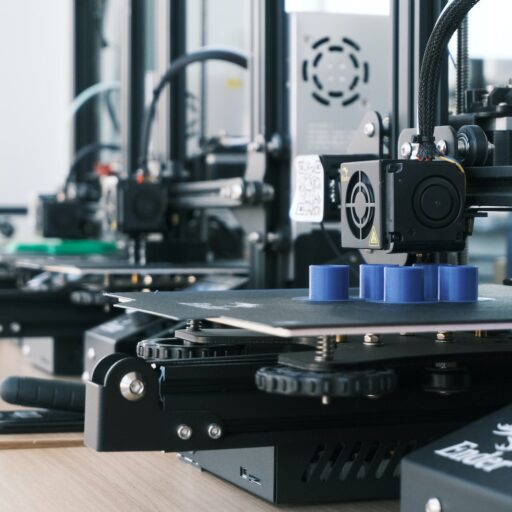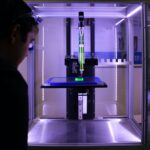Support our educational content for free when you purchase through links on our site. Learn more
[2023] What is a 3D Printer in Simple Terms?
Quick Answer:
A 3D printer is a revolutionary device that can turn digital designs into physical objects by building them layer by layer. It uses various materials, such as plastics, metals, and resins, to create three-dimensional objects with incredible precision and complexity. With the ability to produce customized and intricate designs, 3D printers have found applications in industries like manufacturing, healthcare, and education.
Quick Tips and Facts:
- 3D printing, also known as additive manufacturing, is a process of creating objects by adding material layer by layer.
- The history of 3D printing dates back to the 1980s, with advancements in technologies like stereolithography and selective laser sintering.
- There are different types of 3D printing technologies, including sintering, melting, and stereolithography.
- 3D printing has advantages such as cost-effective production of complex geometries and rapid prototyping, but it also has limitations like lower strength compared to traditional manufacturing.
- An STL file is a format used to define the solid geometry for 3D printable parts.
- 3D printing has applications in industries such as aerospace, automotive, medical, and more.
Background: The Evolution of 3D Printing
The concept of 3D printing has been around for several decades, but it has gained significant attention and popularity in recent years. The technology has evolved from its early stages to become a powerful tool for innovation and creativity.
In the 1980s, the first 3D printing technologies, such as stereolithography and selective laser sintering, were developed. These technologies laid the foundation for the additive manufacturing processes we know today. Over the years, advancements in materials, hardware, and software have led to the development of more sophisticated and accessible 3D printers.
How Does a 3D Printer Work?
A 3D printer works by following a series of steps to transform a digital design into a physical object. Here’s a simplified breakdown of the process:
-
Design: The first step is to create or obtain a digital 3D model of the object you want to print. This can be done using computer-aided design (CAD) software or by downloading pre-made designs from online repositories.
-
Slicing: The 3D model is then sliced into thin layers using slicing software. Each layer is a cross-section of the final object.
-
Preparation: The 3D printer needs to be prepared before printing. This involves ensuring the printer is calibrated correctly, loading the appropriate material, and setting the desired print parameters.
-
Printing: Once the printer is ready, it starts the printing process. The printer deposits or melts the chosen material layer by layer, following the instructions from the sliced model. The material is typically extruded through a nozzle or solidified using a laser or other energy source.
-
Finishing: After the printing is complete, the object may require post-processing to remove support structures, smooth rough surfaces, or add additional details. This can be done through sanding, painting, or other finishing techniques.
Types of 3D Printing Technologies
There are several different types of 3D printing technologies, each with its own advantages and applications. Here are some of the most common ones:
-
Fused Deposition Modeling (FDM): FDM is one of the most popular 3D printing technologies. It works by extruding a thermoplastic filament through a heated nozzle, which then solidifies to form the object layer by layer. FDM printers are affordable, easy to use, and widely available.
-
Stereolithography (SLA): SLA uses a liquid resin that is cured by a UV laser or other light source. The printer selectively solidifies the resin, layer by layer, to create the object. SLA printers are known for their high level of detail and smooth surface finish.
-
Selective Laser Sintering (SLS): SLS printers use a laser to selectively fuse powdered materials, such as plastics or metals, to create the object. The unused powder acts as support, allowing for complex geometries and the production of functional parts.
-
Digital Light Processing (DLP): DLP is similar to SLA but uses a digital light projector to cure the resin instead of a laser. DLP printers can produce high-resolution prints quickly, making them suitable for rapid prototyping.
-
Binder Jetting: Binder jetting involves depositing a liquid binding agent onto a powder bed, layer by layer. The binder solidifies the powder, creating the object. Binder jetting is often used for full-color prototypes and large-scale production.
-
Material Jetting: Material jetting works by jetting droplets of liquid photopolymer onto a build platform. The droplets are then cured using UV light, creating the object layer by layer. Material jetting allows for the production of multi-material and multi-color prints.
-
Direct Metal Laser Sintering (DMLS): DMLS is a metal 3D printing technology that uses a high-powered laser to selectively fuse metal powder particles together. DMLS is commonly used in industries such as aerospace and automotive for producing complex metal parts.
Advantages and Disadvantages of 3D Printing
3D printing offers numerous advantages and has revolutionized various industries. However, it also has its limitations. Let’s take a look at the pros and cons:
Advantages of 3D Printing:
- Cost-effective production of complex geometries: 3D printing allows for the creation of intricate designs that would be difficult or expensive to produce using traditional manufacturing methods.
- Rapid prototyping: 3D printing enables quick iteration and testing of designs, reducing the time and cost associated with traditional prototyping.
- Customization: With 3D printing, it’s possible to create personalized and customized products tailored to individual needs and preferences.
- Reduced material wastage: Unlike subtractive manufacturing processes, which involve cutting away material, 3D printing adds material only where it is needed, minimizing waste.
- Ability to create parts with specific properties: 3D printing allows for the production of parts with unique properties, such as lightweight structures or complex internal geometries.
Disadvantages of 3D Printing:
- Lower strength compared to traditional manufacturing: 3D printed parts may have lower mechanical strength compared to parts produced using traditional manufacturing methods.
- Increased cost at high volume production: While 3D printing is cost-effective for low-volume production, it may become more expensive at high volumes due to material and time constraints.
- Limitations in accuracy: Achieving high levels of accuracy and precision in 3D printing can be challenging, especially for small or intricate features.
- Post-processing requirements: 3D printed parts often require post-processing, such as sanding or painting, to achieve the desired finish or functionality.
- Limited material options: While the range of available materials for 3D printing is expanding, it is still more limited compared to traditional manufacturing processes.
What is an STL File?
An STL (Standard Tessellation Language) file is a widely used format in 3D printing. It defines the solid geometry of a 3D printable object, representing its surface as a collection of triangles. STL files can be created using CAD software or downloaded from online repositories.
The STL file format is widely supported by 3D printing software and hardware. It provides a universal way to transfer 3D models between different systems. However, it is important to note that STL files only contain surface geometry information and do not include color, texture, or other attributes.
3D Printing in Various Industries
3D printing has found applications in a wide range of industries, revolutionizing the way products are designed, prototyped, and manufactured. Here are some examples:
- Aerospace: 3D printing is used in the aerospace industry to produce lightweight components, such as turbine blades and fuel nozzles, with complex internal geometries.
- Automotive: The automotive industry utilizes 3D printing for rapid prototyping, tooling, and the production of custom parts, including interior components and engine parts.
- Medical: 3D printing has transformed the medical field, enabling the production of patient-specific implants, prosthetics, surgical guides, and anatomical models for surgical planning.
- Education: 3D printing is increasingly being integrated into educational curricula, allowing students to learn about design, engineering, and manufacturing in a hands-on and engaging way.
- Architecture: Architects use 3D printing to create detailed scale models, visualize designs, and explore complex geometries that would be challenging to produce using traditional methods.
- Art and Design: Artists and designers are pushing the boundaries of creativity with 3D printing, producing intricate sculptures, jewelry, and fashion pieces.
FAQs

How do you explain 3D printing to a child?
Explaining 3D printing to a child can be done in simple terms. You can say that 3D printing is like using a special machine that can create toys or objects by adding one layer at a time. It’s like building with Legos, but instead of using your hands, the machine does it for you. You can show them examples of 3D printed toys or objects to help them visualize the process.
Read more about “… What is a 3D Printer for Dummies?”
What is the main purpose of a 3D printer?
The main purpose of a 3D printer is to turn digital designs into physical objects. It allows for the creation of customized and complex objects that would be difficult or expensive to produce using traditional manufacturing methods. 3D printers are used in various industries for prototyping, production, and research purposes.
Read more about “… Can a 3D Printer Print Anything? A Comprehensive Guide”
What are some examples of 3D printing?
There are countless examples of what can be created with a 3D printer. Some common examples include:
- Customized phone cases
- Prototypes for new product designs
- Replacement parts for appliances or machinery
- Architectural models
- Prosthetic limbs
- Dental models and aligners
- Jewelry and fashion accessories
Read more about “… What is a 3D Printer Used For? | Best 3D Printer™ Awards”
How long does 3D printing take?
The time it takes to 3D print an object depends on several factors, including the size and complexity of the object, the chosen printing technology, and the desired level of detail. Small and simple objects can be printed in a matter of minutes, while larger and more intricate designs may take several hours or even days to complete.
Read more about “How long does 3D printing take?”
Conclusion
In conclusion, 3D printing is a groundbreaking technology that has revolutionized the way we create and manufacture objects. It allows for the production of customized and complex designs with incredible precision and detail. While 3D printing has its limitations, its advantages in terms of cost-effectiveness, rapid prototyping, and customization make it an invaluable tool in various industries.
If you’re interested in exploring the world of 3D printing further, check out our 3D Printer Reviews for in-depth analysis and recommendations. You can also browse through our 3D Printer Brands section to discover the top-rated printers in the market.
Remember, at Best 3D Printer™, we’re passionate about recognizing the best 3D printers and providing expert advice to help you make informed decisions. Happy printing!
Recommended Links
- Best 3D Printer™ 2023 What is a 3D Printer for Dummies?
- 3D Printers for Small Businesses
- 3D Printers for Education


